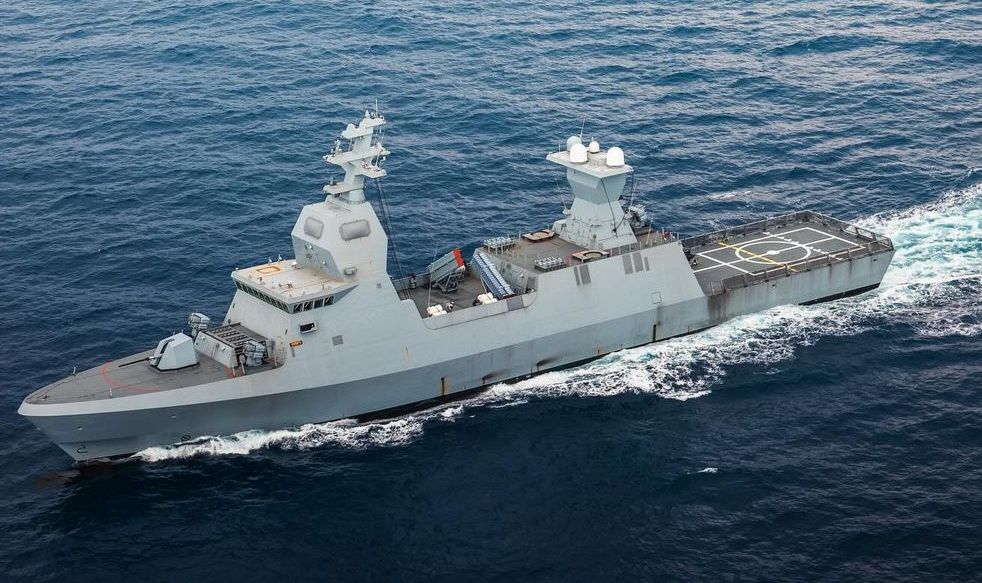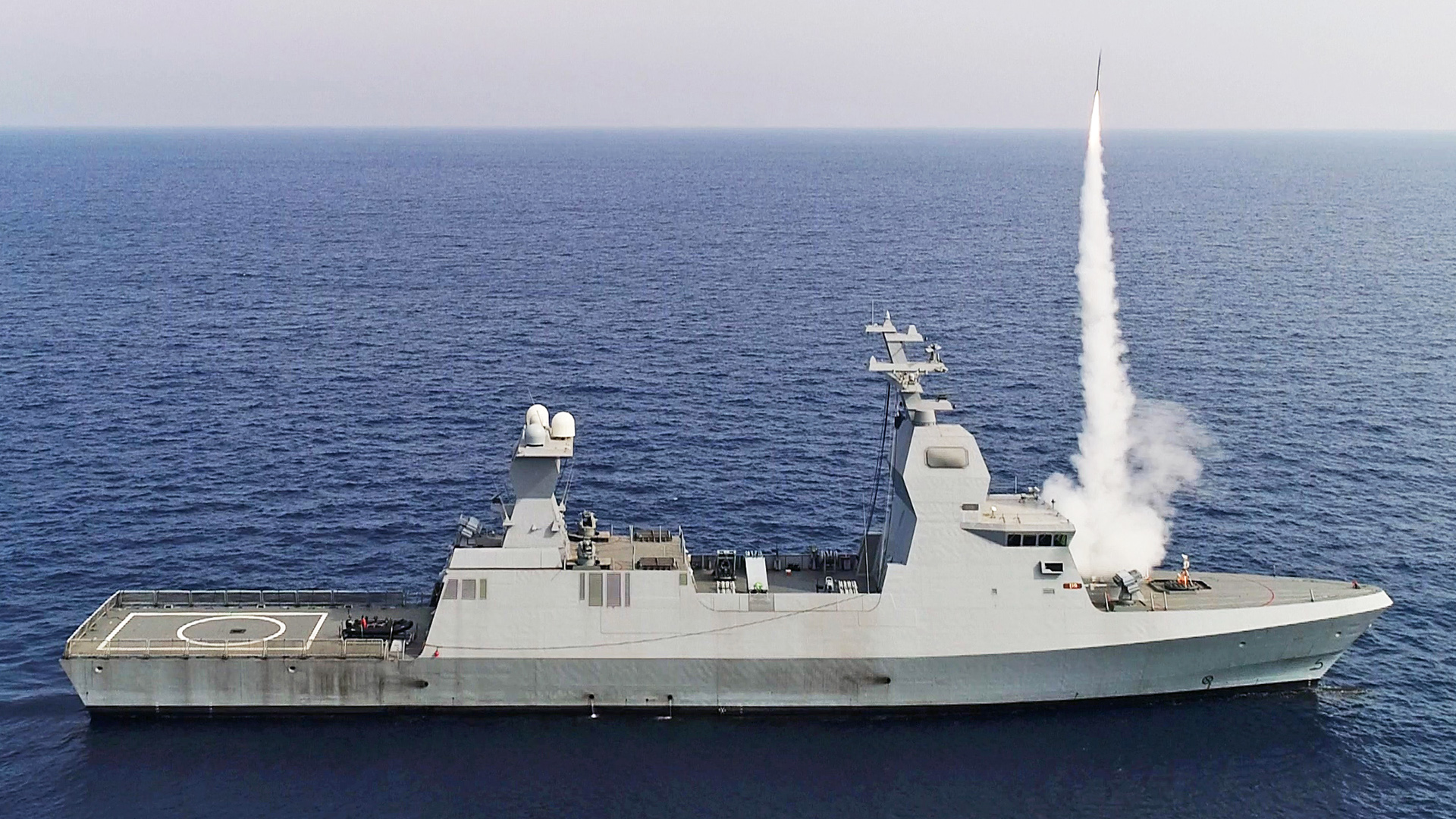Israel has used the ship-based version of its Iron Dome air defense system for the first time in combat. Installed aboard an Israeli Navy Sa’ar 6 class corvette, the navalized Rafael Iron Dome — known as C-Dome — successfully intercepted a drone over the Red Sea. The engagement also comes just a week after one of the Sa’ar 6 class warships was almost struck by a drone launched by militants in Iraq.
Surveillance camera footage, as well as several videos captured by citizens in the Israeli port city of Eilat, on the Red Sea, show at least two interceptor missiles being launched from a C-Dome system aboard a corvette on station there last night. The engagement appears to end with a significant explosion over the sea, as the drone was brought down.
According to the Israel Defense Forces (IDF), the target was intercepted as it entered Israeli airspace near Eilat shortly before midnight, having flown from an eastern direction.
“Drone infiltration sirens” had sounded in Eilat in response to a “suspicious aerial target,” the IDF confirmed.
There were no reports of any damage or injuries as a result of the incident.

In recent months there have been numerous reports of drone and cruise missile attacks against the Eilat area in particular. Many of these have been launched by the Iran-backed Houthi militants in Yemen, who are simultaneously waging a campaign against international maritime traffic in the Red Sea.
At the same time, other drones and missiles are being launched against Israel by the Islamic Resistance in Iraq, a militant group linked to Lebanon’s Hezbollah. This group has been launching its attacks from locations in both Iraq and Syria.
A video recently released by the Islamic Resistance in Iraq shows what appear to be Iranian-designed Quds or Parveh series land-attack cruise missiles fired by the group from a mobile launcher. The targets were claimed to be the Israeli cities of Ashkelon and Beersheba. The distance between the southwestern border of Iraq and Eilat is just over 300 miles, at the shortest point, although any drone or missile would have had to fly over Jordan or Saudi Arabia to reach Israel.
Just last week, one of the Sa’ar 6 class corvettes also came very close to being struck by a long-range one-way attack drone that was launched from Iraq by Islamic Resistance in Iraq. As we reported at the time, the warship was docked in Eilat, on the Gulf of Aqaba, when the drone impacted a warehouse on the pier beside it.
“This is a very serious incident,” Rear Adm. Daniel Hagari, an IDF spokesperson, said about the April 1 strike on Eilat, according to The Times of Israel’s Emanuel Fabian. Hagari also said that the drone was “made in Iran” and the attack was “directed by Iran.” In a post on X, Fabian added that he had been told “that the IDF is learning from the incident to improve its air defenses in the Eilat area.”
It may be that the warship that shot down the drone last night was on station in response to the near-hit on one of the corvettes.
Clearly, striking one of Israel’s most advanced warships would be a major victory for Islamic Resistance in Iraq and it remains possible that the attack last night was also targeting a Sa’ar 6 class corvette or other Israeli Navy assets in the port of Eilat.
As it is, the successful combat debut of the C-Dome does much to prove the expanding air defense capabilities of the Israeli Navy as well as its recently introduced Sa’ar 6 class corvettes. Four of these German-built warships have now been commissioned, with the first of them, INS Magen, having been deployed to the Red Sea for the first time last December.
That deployment was in response to the escalating Houthi offensive, including attacks using drones, cruise missiles, and ballistic missiles. Normally, the Sa’ar 6 class corvettes are primarily expected to defend the highly strategic offshore gas platforms within Israel’s exclusive economic zone (EEZ) in the eastern Mediterranean.

In terms of air defense missiles, each Sa’ar 6 class vessel is armed with two C-Dome systems, each armed with 20 Tamir interceptor missiles, as well as Rafael Barak-8 surface-to-air missiles, which are launched from 32 vertical launch cells.
While the Barak-8 is intended to engage targets out to around 60 miles, including supersonic anti-ship missiles, the C-Dome is designed to intercept and destroy lower-flying aircraft, anti-ship missiles, as well as short-range rockets and artillery shells — and drones.

The naval C-Dome uses the same interceptor missiles and other components from the land-based Iron Dome, together with the ship’s own surveillance radar.
In the Sa’ar 6 class, the C-Dome is installed as a fully integrated vertical launch system. This is in contrast to the earlier Sa’ar 5 ships, which have been noted in the past with one or more land-based Iron Dome batteries installed temporarily on the flight deck. As long ago as 2016, the IDF confirmed that this installation had been successfully tested, shooting down short-range rockets launched from the shore.
Images of twin Iron Dome batteries onboard the Israeli Navy Sa’ar 5 corvette Lahav (linked here if the tweet does not propagate below):
Regardless, now that the Sa’ar 6 class is operational, it brings with it as standard the C-Dome as part of a highly flexible air defense array.
What’s especially notable about the warships in this context is the fact that they are fully integrated within Israel’s wider land-based air defense network that includes Iron Dome, David’s Sling medium/long-range surface-to-air missile, and other assets. You can read all about this unique multi-tier air defense architecture in this previous War Zone feature.

With both the Houthis and the Islamic Resistance of Iraq committed to continuing their attacks on Israel as long as the war in Gaza rages, and regional tensions building between Israel, Iran, and Iranian proxies, there will almost certainly be more opportunity for the Sa’ar 6 class to employ their highly capable air defense systems to engage drones and missiles over the Red Sea. At the same time, the repeated attacks launched against Eilat demonstrate the potential vulnerability of Israeli warships when they are in port here.
Whatever the target of last night’s attack on Eilat, the C-Dome emerged victorious against the drone on this occasion, with an important demonstration of its operational capabilities.
Contact the author: thomas@thewarzone.com
